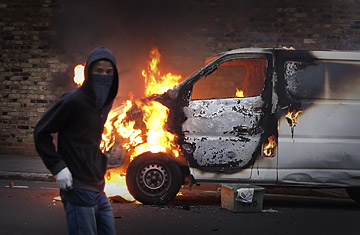
(2 of 2)
Outcast and Outraged
The looting was not, as some observers too swiftly concluded, a race riot. Yes, Duggan was black, and there are strong correlations between race and class in Britain. But some of the worst violence happened in majority-white neighborhoods like Croydon. "This is much broader than race," says Caryl Phillips, a British writer with Afro-Caribbean roots. "This is about a whole group — black, white and brown — who live just outside the law."
Recent years have done little to bring that group into the fold. The unemployment rate for people ages 16 to 24 rose from 14% to 20% over the past three years alone; that's as bad as it has been in two decades and is comparable to joblessness in Arab nations that witnessed youth-led revolutions this year. And yet when the Cameron government looked to slash the budget in a down economy, the ax seemed to fall disproportionately on the very people who were hurting the most. The London boroughs of Hackney and Haringey (which includes Tottenham, where the riots started) were already classified as being among the worst "employment black spots" in London, with 25 applicants for every job, when they were scheduled for reductions of more than 10% in government spending, deeper cuts than in almost all other boroughs.
The few looters who stopped long enough to express a political opinion to journalists blamed Cameron for the conditions that led to the violence. That's a little facile: the Prime Minister has been in office just over a year, and his austerity cuts haven't yet been fully carried out. Besides, Britain's poorest did no better during boom times under Tony Blair and the Labour Party. But some of the disaffection with Cameron and his government has more to do with who they are than with what they've done. The Prime Minister was educated at Eton and Oxford, his deputy Nick Clegg at Westminster and Cambridge. The Cabinet represents the very oldest notions of a British elite, at a time when the U.K. is more diverse than ever and more in debt than it's been in years. "I would define [the riots], in simplistic terms, as class warfare," says Clifford Stott, a social psychologist at the University of Liverpool. "It's class war on the streets of Britain."
Where Were the Bobbies?
The riots were also, inevitably, a failure of policing, which has run both too hot and too cold on the streets of London. Before their numbers increased, to 16,000, on Aug. 9, the police seemed barely in evidence in the capital. Shopkeepers reported getting phone calls from the police warning them to close up in advance of expected looting, but in too many instances, the police didn't show up to stop the violence they knew was brewing. Particularly in light of coming budget cuts that will result in job loss for 1 in 10 police officers — what one British newspaper called the "thinning blue line" — Britons feel undefended. Sales of nightsticks and baseball bats skyrocketed on Amazon UK; the white-supremacist English Defense League pledged to go out and keep the peace itself.
But there was a deeper failure before the riots started, one that undermines the very heart of English policing. Sir Robert Peel founded Scotland Yard in the 19th century with the revolutionary idea that "the police are the public and the public are the police." Unlike their U.S. counterparts, British police are not routinely armed; Peel's idea was that trust and consent were far more important than the threat of force. That's the heritage that Stephen Kavanagh, deputy assistant commissioner of the London Metropolitan Police, invoked during the riots when he said that his force was "not going to throw 180 years of policing with the community away" by escalating its coerciveness.
Two days later, Cameron approved the use of water hoses and rubber bullets after all. But in many districts in London, the police have long felt like a malevolent force. Paul Bagguley, who teaches sociology at the University of Leeds, points to a controversial crackdown on knife violence that led to minorities' being stopped and searched by police some 310,000 times from 2008 to '09; according to statistics from the Ministry of Justice, the vast majority of those searches did not lead to an arrest. The riots stem in part from the desire for "getting one over on the police," he says. Yes, there are organized criminal groups — including the so-called postcode gangs that fight and sometimes die defending their dismal territories — but only 6% of youth are involved, by the Centre for Social Justice's estimate. The broader disaffection with the police is what turned law abiders into lawbreakers and set the stage for the riots.
In front of the burned shell of his great-great-grandfather's store, Graham Reeves said it wasn't his job to be angry. "It's up to the governments of the land and the people that did this to look at themselves," he told reporters. Unfortunately, they're likely to see two very different pictures.
